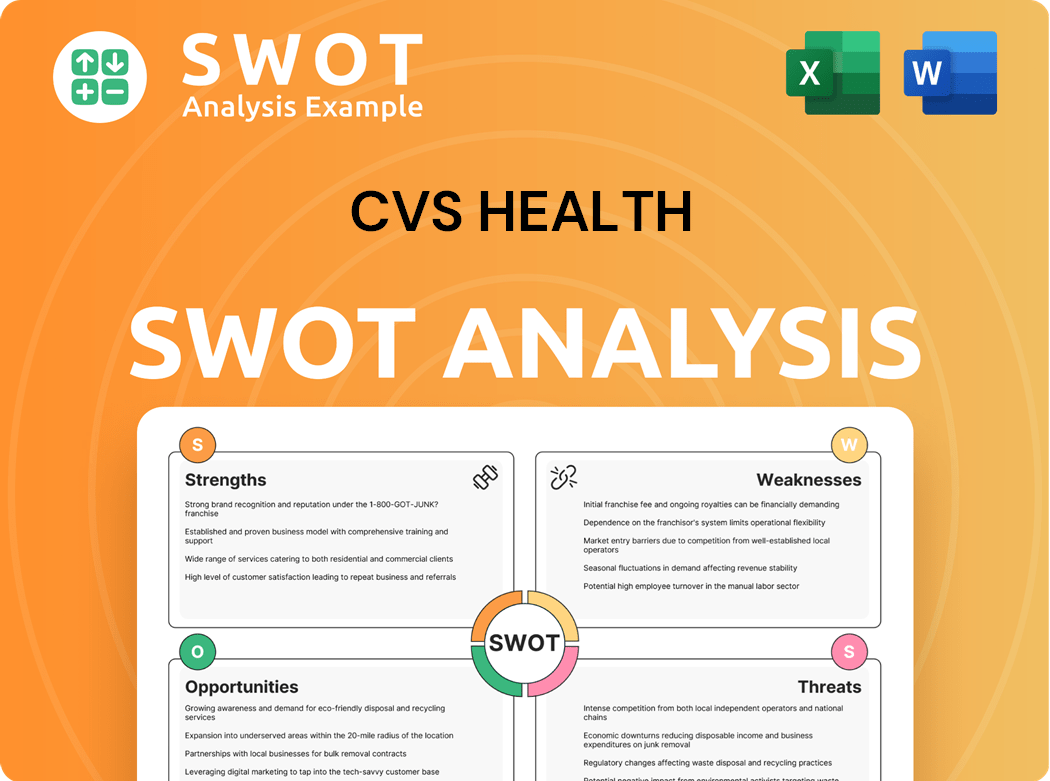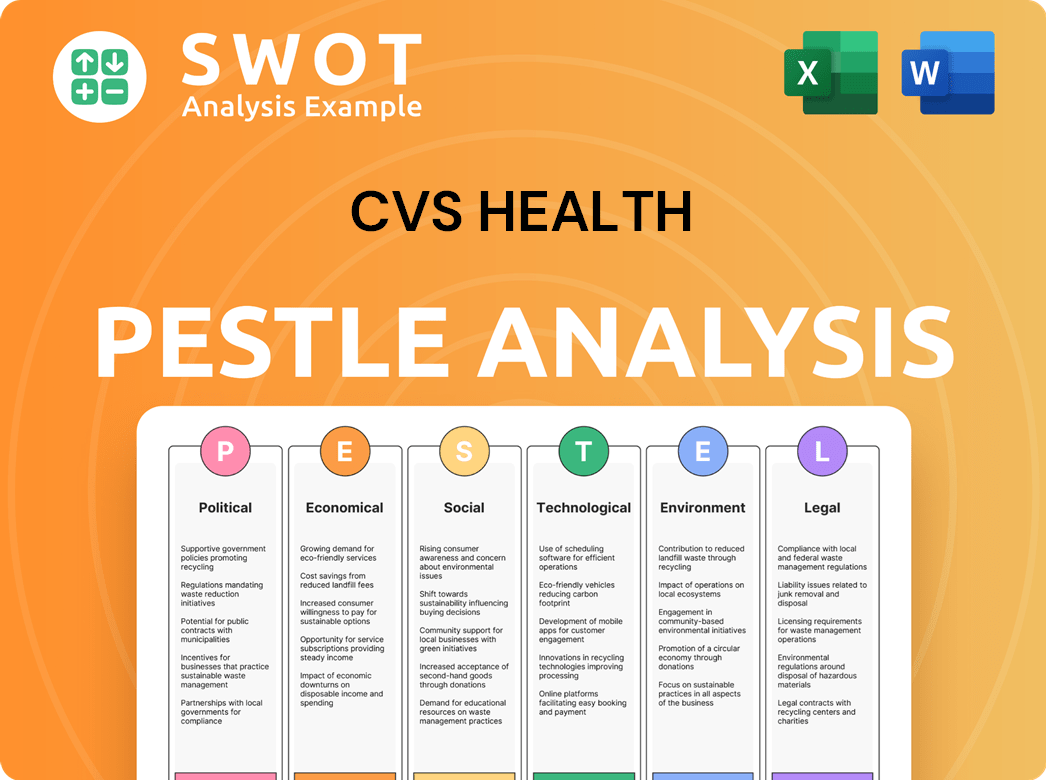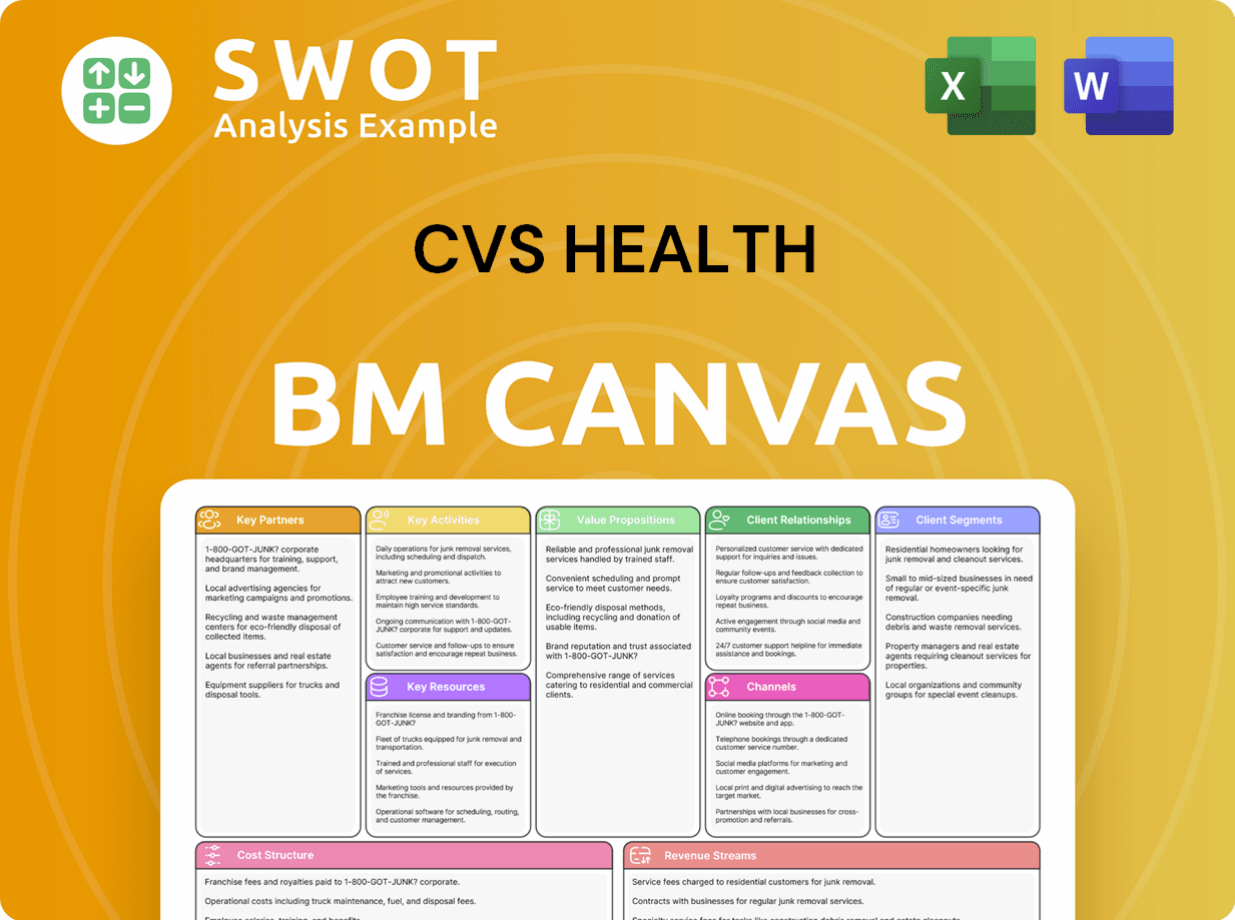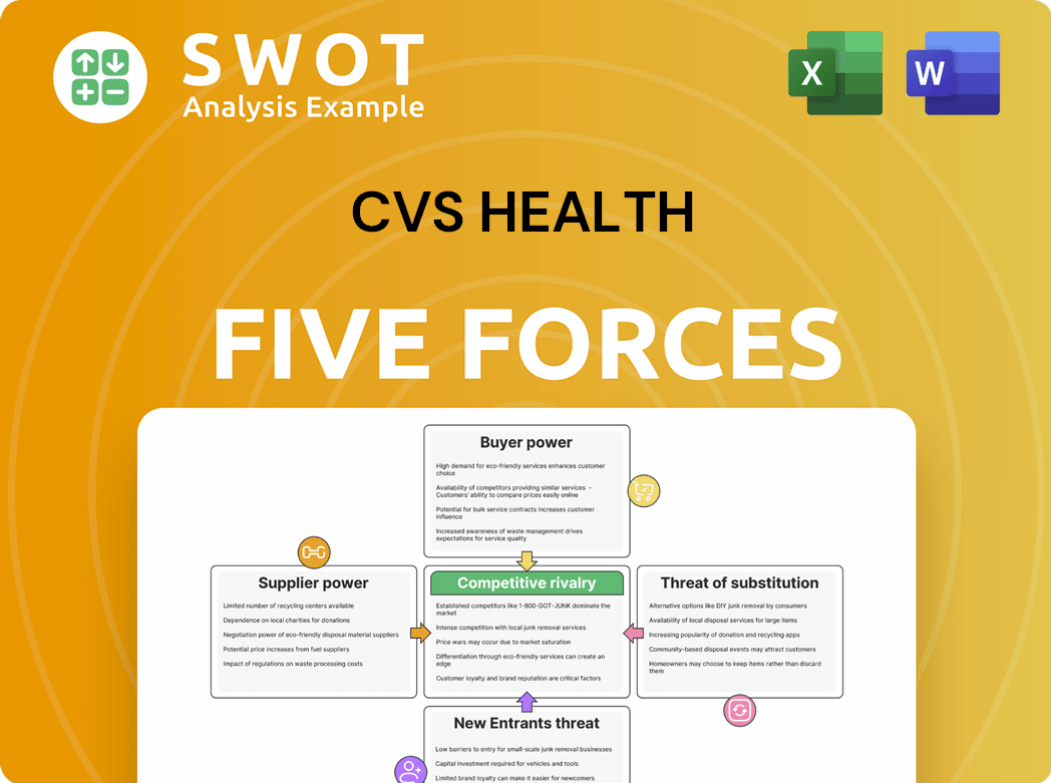CVS Health Bundle
How is CVS Health Revolutionizing Healthcare Sales and Marketing?
From its humble beginnings as a retail pharmacy, CVS Health has dramatically transformed its sales and marketing approach to become a healthcare powerhouse. This evolution involves integrating retail pharmacies, MinuteClinics, Aetna insurance, and pharmacy benefit management services into a unified, patient-centric model. Discover how CVS Health is reshaping the healthcare landscape, making services more accessible and personalized for millions.

This article explores the CVS Health SWOT Analysis, sales and marketing strategies, and the CVS Health business model that have fueled its growth. We'll examine how CVS Health's sales strategy has adapted to a competitive market, analyzing its CVS Health marketing strategy and the impact of acquisitions on CVS Health revenue and CVS Health market share. Learn about CVS Health competitors and how the company uses innovative tactics, including digital marketing and patient engagement, to maintain its position in the dynamic healthcare industry.
How Does CVS Health Reach Its Customers?
The sales and marketing strategy of CVS Health involves a multifaceted approach, leveraging both physical and digital channels to reach its diverse customer base. This strategy has evolved significantly, reflecting the changing healthcare landscape and consumer preferences. The company's approach is designed to enhance customer access to healthcare services and products, driving revenue and maintaining its market share.
CVS Health's sales strategy is centered on an integrated omnichannel model, combining its extensive network of physical retail locations with robust digital platforms. This strategy is supported by strategic partnerships and acquisitions that expand its service offerings and reach. The company's focus on digital adoption and customer engagement is a key component of its long-term growth strategy, enhancing its competitive position in the healthcare industry.
The company's strategy includes a focus on optimizing its retail footprint while expanding its digital health solutions. This dual approach allows CVS Health to cater to a wide range of customer needs and preferences, from in-store purchases to online prescription management and telehealth services. The company's integrated approach aims to improve care quality and manage costs, driving its success in the healthcare market.
CVS Health's primary sales channel has historically been its physical retail locations. With over 9,000 CVS Pharmacy stores nationwide, these locations serve as crucial touchpoints for customers. These stores facilitate prescription refills, over-the-counter purchases, and access to MinuteClinic services.
CVS Health has invested significantly in digital adoption and omnichannel integration. CVS.com facilitates online shopping and prescription management. The CVS Pharmacy mobile app allows customers to order and refill medicines, access health data, and schedule appointments. This digital strategy contributed to the retail segment's revenue in 2022.
The Pharmacy Services segment, including CVS Caremark, is a major revenue contributor. This segment benefits from increased prescription volume and specialty pharmacy services. In 2024, this segment contributed $177.6 billion to total revenue. This highlights the importance of pharmacy services in the overall CVS Health sales strategy.
The Health Care Benefits segment, primarily Aetna, is another significant revenue driver. This segment's revenue was $130.3 billion in 2024, driven by increased membership and higher premiums. This segment's performance demonstrates the impact of the company's health insurance offerings on its overall financial success.
CVS Health's sales channels are diverse, encompassing retail, digital, and B2B segments. The company's approach to sales and marketing strategy involves a combination of physical stores, online platforms, and strategic partnerships. This integrated approach supports the company's overall business model.
- Retail Stores: Offer prescription services, over-the-counter products, and MinuteClinic services. The company is optimizing its retail footprint, planning to close approximately 900 stores by 2024 and an additional 270 in 2025.
- Digital Platforms: CVS.com and the CVS Pharmacy mobile app facilitate online shopping, prescription management, and telehealth services. These platforms are key to CVS Health's digital marketing strategy.
- Pharmacy Services (CVS Caremark): Provides pharmacy benefit management, contributing significantly to revenue. The Pharmacy Services segment generated $177.6 billion in revenue in 2024.
- Health Care Benefits (Aetna): Offers health insurance plans, driving revenue through membership and premiums. The Health Care Benefits segment brought in $130.3 billion in 2024.
- Partnerships and Acquisitions: Strategic collaborations and acquisitions, such as Oak Street Health and Signify Health, expand service offerings and market reach. These initiatives improve care quality and manage costs.
CVS Health SWOT Analysis
- Complete SWOT Breakdown
- Fully Customizable
- Editable in Excel & Word
- Professional Formatting
- Investor-Ready Format

What Marketing Tactics Does CVS Health Use?
The marketing tactics of CVS Health are multifaceted, utilizing a blend of digital and traditional methods to boost brand awareness, generate leads, and drive sales. Their approach is heavily reliant on digital strategies, with significant investments in content marketing, search engine optimization (SEO), paid advertising, email marketing, and social media platforms. This comprehensive strategy is designed to reach a broad audience and engage them effectively.
A key element of the CVS Health sales strategy involves data-driven marketing, customer segmentation, and personalization. This involves dividing customers into distinct groups based on their needs and preferences to offer tailored services and communications. The company leverages advanced analytics to predict consumer behavior, manage inventory, and provide personalized recommendations, enhancing customer engagement and loyalty.
The marketing mix has evolved to include a strong omnichannel presence, ensuring seamless customer interaction across physical stores, online platforms, and mobile apps. This integrated approach aims to provide convenience and a consistent brand experience across all touchpoints. CVS Health's commitment to innovation and technology is evident in its strategic initiatives, including significant investments in technology-enabled consumer health experiences.
CVS Health's digital marketing strategy is a cornerstone of its approach, focusing heavily on online channels to reach and engage customers. This includes a robust SEO strategy to ensure high visibility in health-related searches and significant investment in paid advertising. The company also utilizes email marketing for personalized customer communication and social media platforms for promotional offers and community engagement.
- SEO and Content Marketing: CVS Health focuses on optimizing its digital presence for relevant health-related searches, ensuring discoverability for its pharmacy services, health insurance, and wellness products.
- Paid Advertising: The company spent under $100 million on advertising across digital, print, and national TV in the last year, advertising on over 250 different media properties.
- Email Marketing: CVS Health's email marketing strategy emphasizes personalization and customer retention, tailoring content to individual preferences with offers, health tips, and reminders.
- Social Media: Platforms like Facebook, Twitter, Instagram, and LinkedIn are actively used for promotional offers, health tips, and community engagement.
CVS Health's marketing strategy is heavily influenced by data analytics and customer segmentation. The company segments customers based on their needs and preferences to offer personalized and relevant services. This approach allows for targeted marketing campaigns and more effective customer engagement. CVS Health utilizes advanced analytics to predict consumer behavior, manage inventory, and provide personalized recommendations.
- Customer Segmentation: Customers are grouped based on their needs, characteristics, and preferences to offer personalized and relevant services. For instance, retail shoppers receive coupons and recommendations based on purchase history, while health enthusiasts are targeted with services like vitamin supplements and health trackers.
- Advanced Analytics: CVS Health utilizes advanced analytics to predict consumer behavior, manage inventory, and provide personalized recommendations.
- Technology Platforms: Technology platforms and analytics tools, including data, analytics, and generative AI, play a significant role in enhancing customer engagement, loyalty, and convenience.
CVS Health has evolved its marketing mix to include a strong omnichannel presence, ensuring seamless customer interaction across physical stores, online platforms, and mobile apps. This integrated approach aims to provide convenience and a consistent brand experience across all touchpoints. The CVS Pharmacy app is a central hub for managing prescriptions, benefits, and appointments. Strategic initiatives for 2025 include a planned investment of $20 billion over the next 10 years to build a more technology-enabled consumer health experience, focusing on interoperability and enhancing digital products.
- Omnichannel Strategy: Ensuring seamless customer interaction across physical stores, online platforms, and mobile apps.
- CVS Pharmacy App: Serves as a central hub for managing prescriptions, benefits, and appointments.
- CVS Media Exchange (cMx): A data-led media network that allows advertisers to reach CVS shoppers through various digital platforms.
- Strategic Investments: A planned investment of $20 billion over the next 10 years to build a more technology-enabled consumer health experience.
Understanding the Competitors Landscape of CVS Health is crucial for appreciating the effectiveness of its marketing strategies. The company's ability to adapt and innovate in its marketing tactics is critical for maintaining its market share and revenue in a competitive environment.
CVS Health PESTLE Analysis
- Covers All 6 PESTLE Categories
- No Research Needed – Save Hours of Work
- Built by Experts, Trusted by Consultants
- Instant Download, Ready to Use
- 100% Editable, Fully Customizable

How Is CVS Health Positioned in the Market?
CVS Health strategically positions itself as a leading healthcare provider, focusing on accessibility and affordability for a vast customer base. The company's brand message emphasizes improving individual well-being through integrated healthcare services, including retail pharmacies, MinuteClinic, and Aetna insurance plans. This integrated approach is a key differentiator in the competitive healthcare market, allowing for a holistic and personalized patient experience.
The company's brand identity is built on trust and a commitment to health and wellness. In June 2025, the company's health and wellness products will feature new, simplified packaging designed to highlight key benefits. This update aims to enhance brand visibility and streamline the shopping experience for consumers. The company's commitment to community health initiatives and corporate social responsibility programs further strengthens its brand image.
The company's unique selling proposition centers on value, accessibility, and a comprehensive approach to health. For example, the ExtraCare rewards program is one of the largest retail loyalty programs in the country, offering personalized discounts and rewards. The omnichannel strategy ensures a consistent customer experience across all touchpoints. To learn more about its origins, consider reading Brief History of CVS Health.
CVS Health offers integrated healthcare services, including retail pharmacies, MinuteClinic services, and Aetna insurance. This integration provides a comprehensive approach to healthcare, enhancing convenience and accessibility for customers. The integration is a key aspect of its
CVS Health emphasizes making healthcare accessible and affordable. MinuteClinic branding highlights 'affordable care, wherever and whenever patients need it'. This focus is crucial for attracting and retaining customers in a competitive market.
The visual identity and tone of voice are designed to convey trustworthiness and a focus on health and wellness. The company's brand identity is consistent across all channels. This consistency ensures a cohesive customer experience.
The ExtraCare rewards program is a key component of CVS Health's customer engagement strategy. The program offers personalized discounts and rewards, fostering customer retention. This strategy contributes to the
CVS Health employs several key strategies to maintain its brand position and achieve its goals. These strategies include:
- Integrated Healthcare Model: Leveraging the synergy between pharmacies, clinics, and insurance to offer comprehensive care.
- Digital Transformation: Enhancing customer experience through digital platforms and telehealth services.
- Community Engagement: Supporting local communities through health initiatives and CSR programs.
- Value-Based Care: Focusing on providing affordable and accessible healthcare solutions.
- Strategic Partnerships: Collaborating with other healthcare providers to expand services and reach.
CVS Health Business Model Canvas
- Complete 9-Block Business Model Canvas
- Effortlessly Communicate Your Business Strategy
- Investor-Ready BMC Format
- 100% Editable and Customizable
- Clear and Structured Layout

What Are CVS Health’s Most Notable Campaigns?
The sales and marketing strategies of CVS Health are multifaceted, focusing on digital transformation, cost optimization, and expanding healthcare services. These strategies are designed to enhance customer engagement, improve operational efficiency, and drive revenue growth. The company's approach includes significant investments in technology and strategic partnerships to maintain its competitive edge in the healthcare market.
Key initiatives include the development of a new, all-in-one app, the implementation of a new economic model for prescriptions, and the expansion of HealthHUBs and MinuteClinic locations. These efforts are supported by targeted marketing campaigns and strategic collaborations. These campaigns aim to improve customer experience, increase market share, and ensure long-term sustainability.
By analyzing Revenue Streams & Business Model of CVS Health, we can better understand the company's strategic focus on integrating healthcare and retail services.
CVS Health is investing heavily in digital transformation, with a $20 billion investment planned over the next 10 years, spearheaded by CEO David Joyner since October 2024. A key part of this is the new, all-in-one CVS Health app launched in January 2025. This app integrates pharmacy benefits, prescriptions, and health services.
CVS Health implemented CVS CostVantage™ in January 1, 2025. This model aims to provide more transparent and predictable pricing for prescriptions, including the full pass-through of rebates. This initiative is designed to improve affordability and access to specialty medications.
The ongoing expansion of HealthHUBs and MinuteClinic locations is a key strategy to provide a wider range of health services. These locations offer chronic disease management, vaccinations, and treatment for minor illnesses. This helps attract more customers and increase revenue.
CVS Health collaborates with other healthcare organizations, businesses, and institutions. These partnerships aim to expand reach and offer innovative solutions. They also address challenges in the Aetna business, as seen in 2024, to improve margins in 2025.
The new CVS Health app saw a 22% increase in active users and a 23% increase in downloads in 2024, with 14.1 million monthly users. The focus on digital marketing supports the app's growth. These metrics highlight the effectiveness of the digital-first approach.
- The implementation of CVS CostVantage™ is designed to improve the affordability of prescription medications.
- HealthHUBs and MinuteClinics aim to increase revenue per customer by offering a broader range of healthcare services.
- Strategic collaborations are designed to expand CVS Health's market presence and offer innovative healthcare solutions.
- The Aetna business realignment in 2024 is a strategic effort to improve future financial performance.
CVS Health Porter's Five Forces Analysis
- Covers All 5 Competitive Forces in Detail
- Structured for Consultants, Students, and Founders
- 100% Editable in Microsoft Word & Excel
- Instant Digital Download – Use Immediately
- Compatible with Mac & PC – Fully Unlocked

Related Blogs
- What are Mission Vision & Core Values of CVS Health Company?
- What is Competitive Landscape of CVS Health Company?
- What is Growth Strategy and Future Prospects of CVS Health Company?
- How Does CVS Health Company Work?
- What is Brief History of CVS Health Company?
- Who Owns CVS Health Company?
- What is Customer Demographics and Target Market of CVS Health Company?
Disclaimer
All information, articles, and product details provided on this website are for general informational and educational purposes only. We do not claim any ownership over, nor do we intend to infringe upon, any trademarks, copyrights, logos, brand names, or other intellectual property mentioned or depicted on this site. Such intellectual property remains the property of its respective owners, and any references here are made solely for identification or informational purposes, without implying any affiliation, endorsement, or partnership.
We make no representations or warranties, express or implied, regarding the accuracy, completeness, or suitability of any content or products presented. Nothing on this website should be construed as legal, tax, investment, financial, medical, or other professional advice. In addition, no part of this site—including articles or product references—constitutes a solicitation, recommendation, endorsement, advertisement, or offer to buy or sell any securities, franchises, or other financial instruments, particularly in jurisdictions where such activity would be unlawful.
All content is of a general nature and may not address the specific circumstances of any individual or entity. It is not a substitute for professional advice or services. Any actions you take based on the information provided here are strictly at your own risk. You accept full responsibility for any decisions or outcomes arising from your use of this website and agree to release us from any liability in connection with your use of, or reliance upon, the content or products found herein.